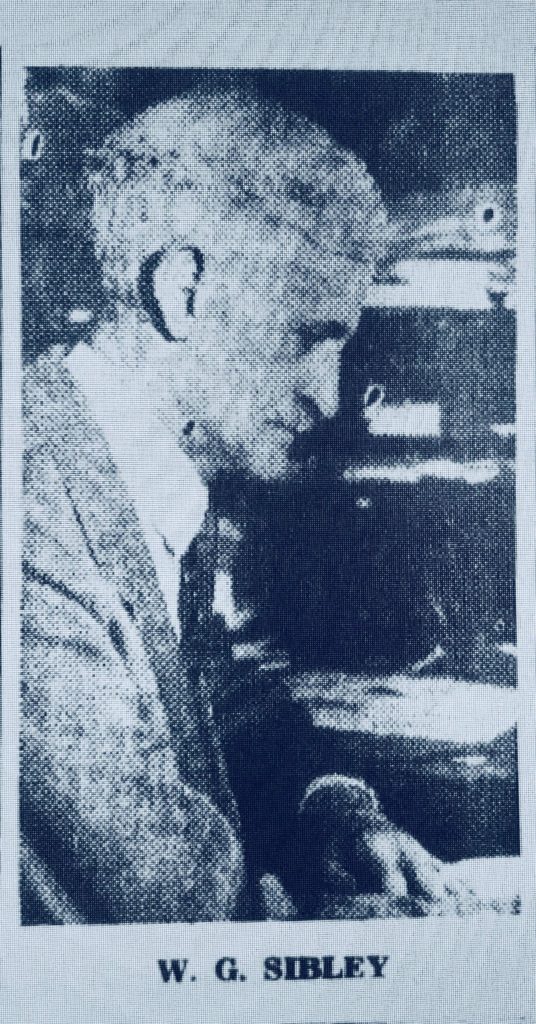Remembering the writing and accomplishments of W.G. Sibley

W.G. Sibley

When someone thinks of well-known authors or famous journalists from Meigs County, usually two people come to mind: Ambrose Bierce and James Edwin Campbell. While both have incredible works in their own right as authors, W.G. Sibley of Racine has an interesting life story of not only local and national journalism, but also as an author of several different books.
William Giddings Sibley was born February 29, 1860 and died January 30, 1935. While he lived to the age of 74, he was only able to celebrate the anniversary of his birth 18 times as he was born on leap-day. As a young man, he enrolled in Marietta College, graduating in 1881. Sibley would go on to establish the Hiram L. Sibley Fund at Marietta College in memory of his father, Judge Hiram L. Sibley. The income from the fund was used to support the acquisition of information resources for the college. Marietta College eventually honored Sibley with both an honorary Masters of Arts degree and honorary “Doctorate of Humanities” degree. He also served as Captain and quartermaster of the 7th regiment of the Ohio National Guard in 1902 and 1903. Around this point in his life, Sibley became involved with the Masonic fraternity, eventually becoming a Knight Templar and a 32nd Degree Scottish Rite Mason.
After graduating college, Sibley returned to Racine and worked as a clerk at Ellis’ store from 1881 to 1887, which he commonly referred to as “the great family store” in many of his articles. Later in 1887, he founded and became the editor of a weekly newspaper, The Meigs County Tribune. On top of this, he became state librarian of Ohio in 1889 and 1890. Sibley remained editor of The Meigs County Tribune for three years until he sold to a rival newspaper, The Pomeroy Telegraph, and from then on the merged paper was known as The Pomeroy Tribune-Telegraph, which was published into the mid-1940s. Ironically, after hoping to get out of journalism, Sibley purchased the weekly Gallipolis Weekly Tribune and decided to turn it into a daily newspaper. Thus, the Gallipolis Daily Tribune was born and would eventually become the only daily newspaper of Gallia County.
Sibley was well known, for lack of a better term, to speak his mind. Shortly after converting the Gallipolis Tribune to a daily paper, Sibley had this to say about, what we would call “slum-lords” today:
… Men who will buy up old shanties because they can get them for a song, and rent them to whoever they can get to occupy them, are enemies to the moral and material prosperity of a community….Men who deal in that kind of real estate invite into the community on the one hand, all the vagabond element they have room for and on the other hand, are doing what they can to drive into vagabondism all who by sheer necessity are compelled to live in their miserable huts; for nothing so disheartens and degrades humanity as to chuck them in such cheerless surroundings.
Sibley remained the editor and publisher of The Gallipolis Daily Tribune until 1920, when Dr. Charles E. Holzer purchased the company.
During the same year Sibley sold the Gallia paper, he was offered a job in Omaha, Nebraska as editor of The Bee newspaper. Unsettled and unhappy in Nebraska, after only a few months, Sibley returned to Gallia County and became chief editorial writer for The Chicago Daily Journal of Commerce. His editorials eventually developed into a column named Along the Highway which ran in various newspapers all over the country, including the Gallipolis Daily Tribune.
One could argue that with Sibley’s involvement with any publication came controversy in his writing. This, in turn, sold his newspapers time and time again, if only for patrons to see his opinions, and points of discussion on any matter at hand. In his book Thrifts of Joy, he argued against nationwide frivolous spending and national excess after World War I. Gallia County’s infamous O.O. McIntyre worked alongside Sibley and had this had this to say about him: “He loved his hometown, its people and its newspaper. As he grew older, he took on the serene dignity of thoughtful years. He had a finely chiseled face, a mop of tumbly hair, turned white, like Mark Twain, and deep-set, piercing eyes. One knew at once he was somebody.”
Sibley also wrote several books throughout his lifetime, as well as posthumously having his Along the Highway articles turned into a book. Some of his books include:
A history of the Rose Commandery No. 43, Knights Templars, Gallipolis, Ohio (1900)
The French 500 (1901)
The Budget (1903)
The Story of Freemasonry (1904)
Morning Dawn Lodge Number Seven, F. & A.M., Gallipolis, Ohio; An Historical Sketch (1910)
Gallipolis in the Cradle: An Address on the 125th Celebration of the Founding of Gallipolis (1915)
Recollections of Marietta College, 1874-1881 (1928)
Old Ohio River Steamboat Days; Memories of Upper Ohio River Activities Between 1860 and 1890 (1932)
Along the Highway with W.G. Sibley; Extracts from a Column Under this Title Appearing in the Chicago Journal of Commerce. (January 26, 1924 to January 30, 1935.) (released posthumously)
As the old Ohio flows…









